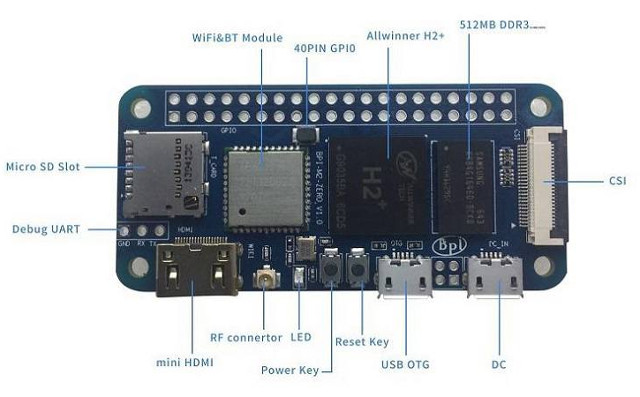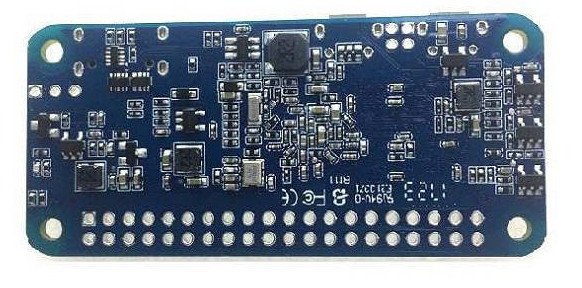Many development boards have followed Raspberry Pi 2/3 form factor in recent years, including Hardkernel ODROID-C2 and Pine64 ROCK64, but so far I had not seen any boards leveraging Raspberry Pi Zero (W) form factor.
SinoVoIP will change that, as they’ve just launched Banana Pi M2 Zero (aka BPI-Zero) board powered by Allwinner H2+ quad core processor, leveraging Raspberry Pi Zero W form factor, and now selling on Aliexpress for $15 plus shipping.
 Banana Pi M2 Zero specifications:
Banana Pi M2 Zero specifications:
- SoC – Allwinner H2+ quad core Cortex A7 processor @ up to 1 GHz with Mali 400MP2
- System Memory – 512 MB DDR3
- Storage – micro SD card slot up to 64GB
- Video/Audio Output – mini HDMI
- Connectivity – 802.11 b/g/n WiFi and Bluetooth LE (AP6212 module with options for AP6181, AP6335)
- Camera – 1x MIPI CSI connector supporting 8-bit YUV422 CMOS sensor, CCIR656 protocol for NTSC and PAL, 5MP camera, 1080p video @30Hz
- USB – 1x micro USB OTG, 1x micro USB port for power only
- Expansion – 40-pin mostly compatible Raspberry Pi header with
- Misc – Reset and power buttons; power and status LEDs, 3-pin UART header
- Power Supply – 5V/2A via micro USB port
- Dimensions – 60 x 30 mm (Mistake? RPi Zero W is 65 x 30 mm)
- Weight – 35 grams
The board is said to support Android, Ubuntu, Debian and “Raspberry Pi” images. The latter obviously means Raspbian with Allwinner H2+ Linux kernel and U-boot, not the actual Raspbian for Raspberry Pi images. But currently, only Ubuntu 16.04 Mate image with Linux 3.4.113 appears to be available for download, and documentation is not ready yet. You might consider trying Armbian image for Orange Pi Zero, or even Ubuntu 16.04.2 image for NanoPi Duo. Both images might need some tweaking with device tree file, and the WiFi module.
 A few more details may be available on the product page. Shipping on Aliexpress varies a lot depending on destination, with reasonable $4-$7 fee to the US and Germany, but I’ve seen between $15 and $30 to other countries.
A few more details may be available on the product page. Shipping on Aliexpress varies a lot depending on destination, with reasonable $4-$7 fee to the US and Germany, but I’ve seen between $15 and $30 to other countries.

Jean-Luc started CNX Software in 2010 as a part-time endeavor, before quitting his job as a software engineering manager, and starting to write daily news, and reviews full time later in 2011.
Support CNX Software! Donate via cryptocurrencies, become a Patron on Patreon, or purchase goods on Amazon or Aliexpress




